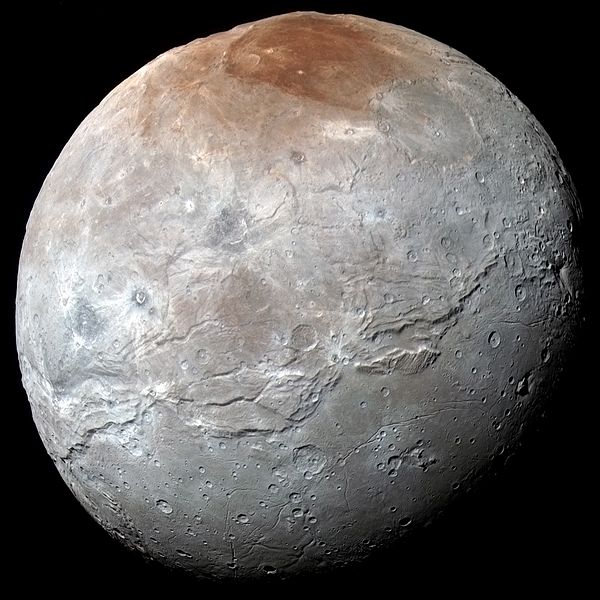In a recent study scheduled to be published in the journal Icarus in March 2023, a team of researchers led by the Southwest Research Institute (SwRI) modeled a potential correlation between an ancient freezing ocean with cryovolcanic flows and surface canyons on Pluto’s largest moon, Charon. Their hypothesis was that when Charon’s interior ocean froze long ago, the significant stress put on the icy outer shell from the addition of more ice to the bottom of the existing shell could have been responsible for the cryovolcanic flows on the surface.
In the end, the researchers found a freezing interior ocean was likely not responsible for Charon’s cryovolcanic flows due to the ice shell needing to be much thinner than indicated by current models. But if an interior ocean isn’t responsible for Charon’s cryovolcanic flows, then what could be responsible?
“My best guess is that Charon’s thermal evolution and geologic processes created pockets of melt within the ice shell that eventually migrated to the surface,” Dr. Alyssa Rhoden, who is a Principal Scientist at SwRI and lead author of the study, recently told Universe Today. “On moons like Europa, we think of areas with a high concentration of salt, which can affect the melting temperature and density of ice in a local region. On Charon, there are also nitrogen-bearing compounds, like ammonia, that can affect how melt forms and moves through the ice shell.
“It is also possible that the flows were made of oceanic material,” Dr. Rhoden continued. “Our study looked at the combined effects of fracture formation and ocean pressurization that occurs as an ocean freezes out. We found that ocean freezing could not generate both the conduits that connect the ice shell with the ocean and the pressure needed to bring ocean material to the near-surface, unless the ice shell was much MUCH thinner than models suggest it could have been. It’s still possible that fractures were created by some other process (or combination of processes) that enabled ocean material to transit the ice shell. But we can’t simply invoke ocean freezing as the direct path to ocean-sourced eruptions.”
As stated, Charon is the largest moon of Pluto, and is nearly half the size of its parent dwarf planet, making it the largest known satellite relative to its parent body, and is even larger than Pluto’s other four moons combined. The only spacecraft to have visited both Pluto and Charon was NASA’s New Horizons in July 2015, which took incredible images and gave us new insights about both celestial bodies. Despite this flyby happening more than seven years ago, scientists continue to learn more about this mysterious moon, to include its ancient ocean and how it could have affected the surface.
“What this research teaches us is that Charon’s freezing ocean had a more limited role in the development of Charon’s surface geology than has been previously suggested,” Dr. Rhoden recently told Universe Today. “Most likely, Charon’s large canyon systems are the main geologic indicators of ocean freezing.”
As it turns out, Charon isn’t the only ocean-bearing world in our solar system, even though its ocean has long since frozen. Moons like Europa, Enceladus, and Titan have all been examined in-depth regarding their (potential) interior bodies of liquid water. So, can this research teach us anything new about other ocean-bearing worlds in our solar system?
“All ocean worlds should be influenced by the same processes,” Dr. Michael Manga, who is a Professor and Chair of the Department of Earth and Planetary Sciences at UC Berkeley and a co-author on the study, recently told Universe Today. “The differences will be controlled by the size of the world which affects gravity and the thickness of the ice shell. On Enceladus, for example, the small size and thin ice shell make it possible to produce cracks the connect the ocean to the surface.”
“Diversity is important! Dr. Rhoden recently exclaimed to Universe Today. “Not just diversity of people and perspectives (which is also critical) but harnessing the power of comparative planetology is key to understanding the properties and processes of icy worlds. Here, we built upon an investigation of Europa and expanded to better understand Enceladus and Charon. And now, we can use our understanding of the effects and limits of ocean freezing to constrain the histories of many other moons in the solar system.”
While several missions have been proposed to return to the Pluto system, there are currently no scheduled missions at this time. What new insights will we continue to unlock regarding Charon and other ocean worlds in the coming years? Only time will tell, and this is why we science!
As always, keep doing science & keep looking up!

